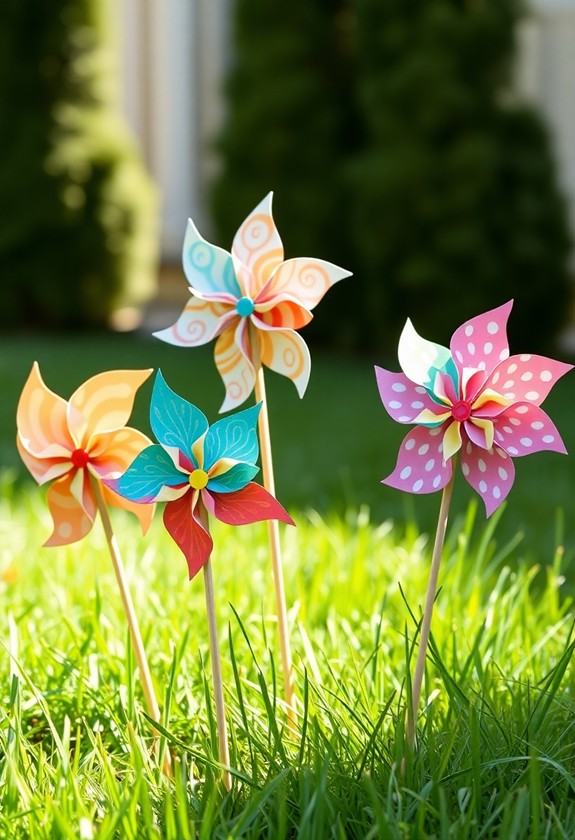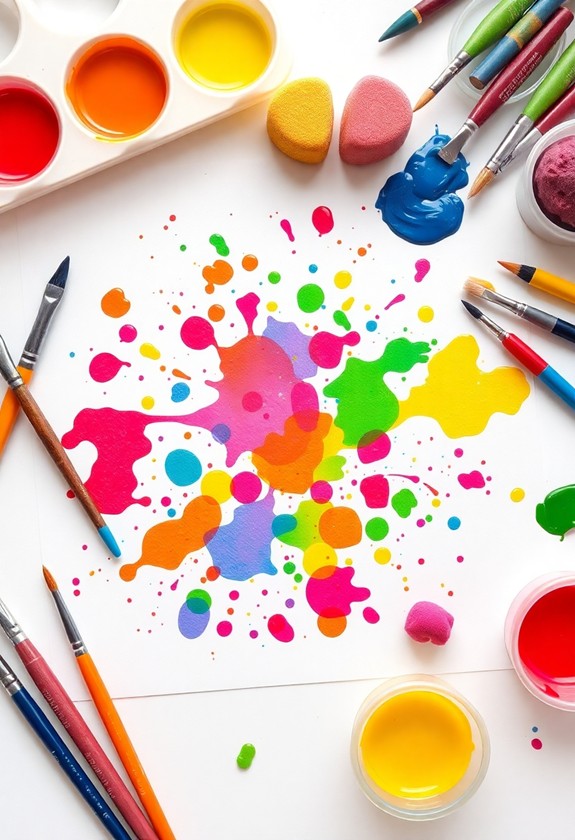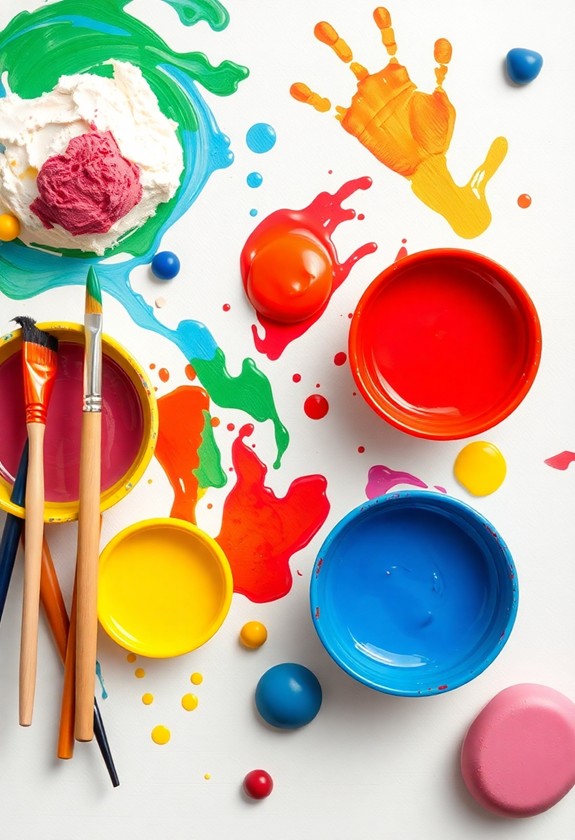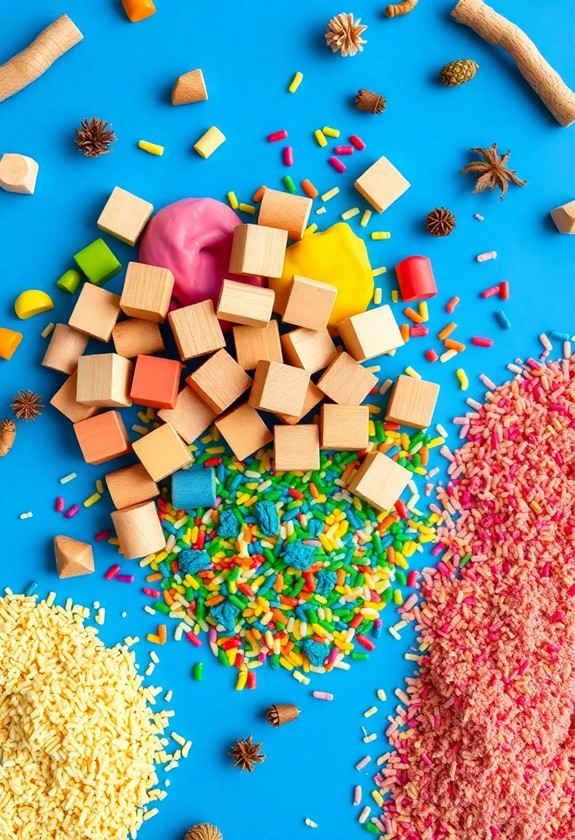Get ready to liberate your toddler's creativity with these budget-friendly, eco-art projects! Transform cardboard boxes into majestic sculptures, craft adorable creatures from paper towel rolls, and bring egg cartons to life as cute caterpillars. Turn bottle caps into lively mosaics, investigate mess-free painting with plastic bags, and create newspaper collages for texture-rich fun. Don't forget to upcycle tin cans into personalized pencil holders! These activities not only spark imagination but likewise teach valuable lessons about recycling and reusing materials. Your little one will have a blast as they develop fine motor skills and environmental awareness. Excited to jump in? There's so much more to investigate with these eco-friendly masterpieces!
Creative Highlights
- Cardboard box sculptures encourage creativity while teaching eco-friendly habits and developing fine motor skills.
- Paper towel roll creatures foster imaginative play and problem-solving using readily available household materials.
- Egg carton caterpillars promote upcycling and enhance artistic expression for preschoolers with minimal supplies.
- Bottle cap mosaics offer a colorful, budget-friendly activity that improves sorting skills and color recognition.
- Plastic bag finger painting provides a mess-free, engaging art experience using common household items.
Cardboard Box Sculptures
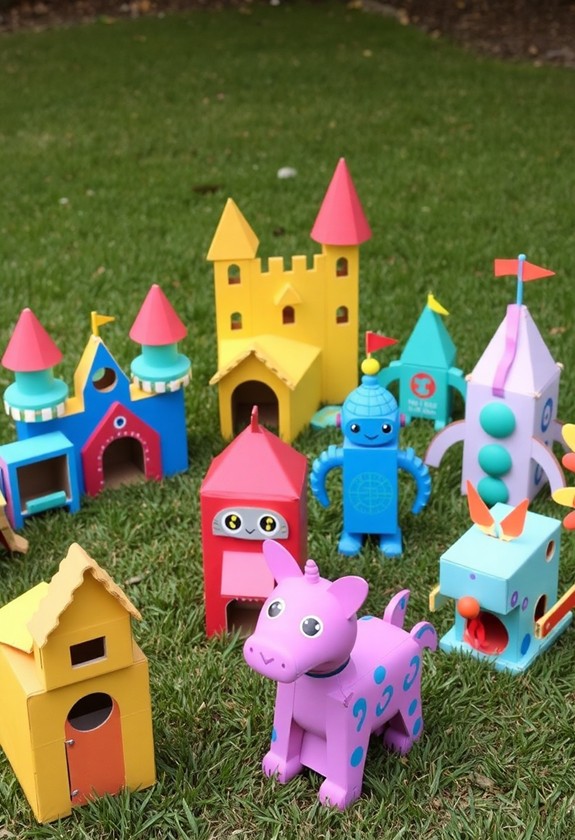
With a little imagination, cardboard boxes transform into the perfect medium for toddler-friendly eco-art. These versatile recyclables are just waiting to become your child's next masterpiece! Start by gathering boxes of various sizes and shapes. Now, let the fun begin! This activity promotes worry-free creativity as it allows toddlers to express themselves without concerns about making a mess. Plus, it's an excellent way to reuse materials and teach eco-friendly habits.
Here's how to create amazing cardboard sculptures:
- Cut openings for windows and doors
- Stack and glue boxes together
- Paint with non-toxic, water-based colors
- Add decorations like stickers or fabric scraps
Your little one can build castles, robots, or even a cardboard car! The possibilities are endless, and the best part? It's all eco-friendly! Plus, it's a great way to develop fine motor skills and spatial awareness. So, don't toss those boxes – turn them into treasure! Remember, one person's trash is a toddler's artistic playground. Get ready for some box-tastic fun!
Paper Towel Roll Creatures
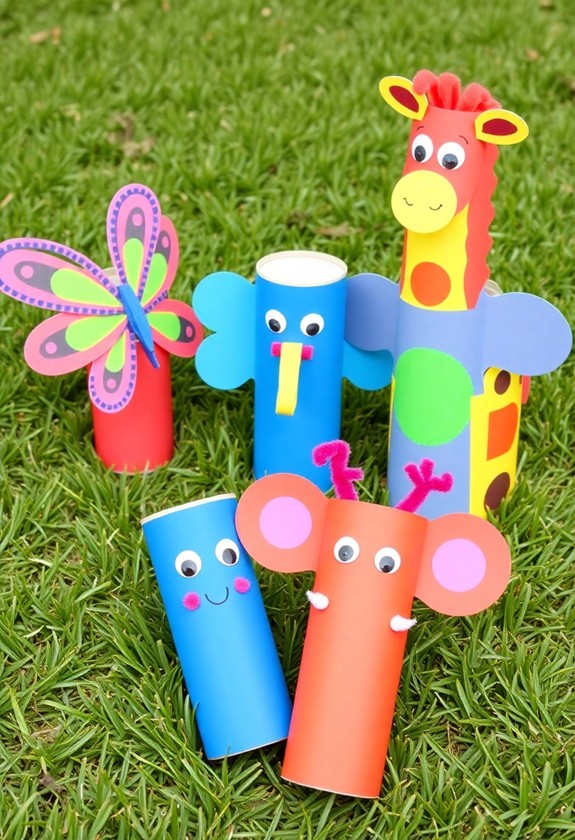
Twisting and turning, paper towel rolls can become fantastic creatures in the hands of your imaginative toddler. This eco-friendly craft is a blast! Here's how to make it happen:
- Gather empty paper towel rolls
- Cut some rolls in half for variety
- Grab paint, markers, and glue
Now, let your little one's creativity soar! They can paint the rolls wild colors, add googly eyes, or glue on feathers. This craft promotes sustainability as it encourages creative thinking and problem-solving abilities. Encourage them to make:
- Silly snakes
- Towering giraffes
- Crazy caterpillars
But wait, there's more! Use scissors to create tentacles for an octopus or fringe for a lion's mane. The possibilities are endless! These paper towel roll creatures aren't just fun – they're teaching your toddler about recycling and imagination. So, roll with it and watch their artistic skills grow!
Egg Carton Caterpillars
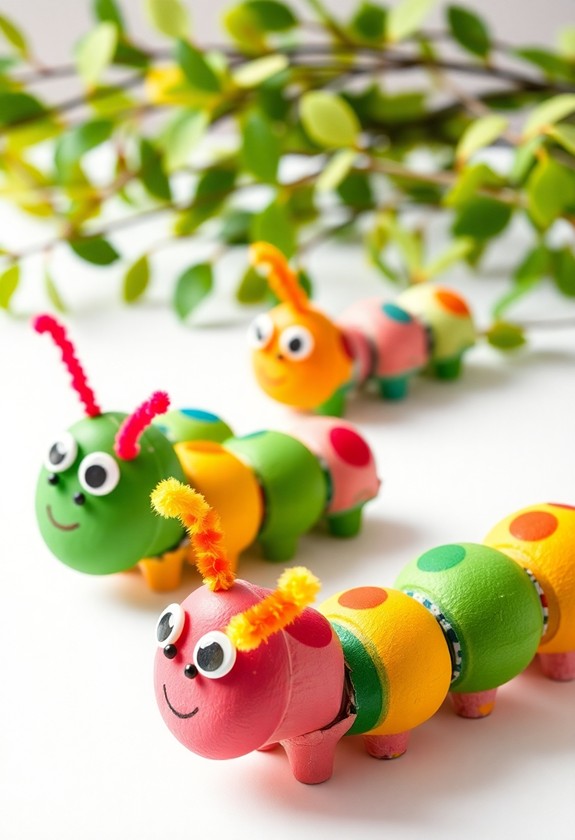
From rolling tubes to recycling cartons, we're keeping the eco-friendly creativity flowing! Now, let's turn those empty egg cartons into adorable caterpillars! This project promotes fine motor skills and encourages imaginative play, perfect for preschoolers. Using washable, non-toxic paints guarantees easy cleanup and safety for little artists.
Here's what you'll need:
- Empty egg carton
- Scissors
- Paint and brushes
- Pipe cleaners
- Googly eyes
- Glue
Ready to get crafty? Let's go!
- Cut the egg carton into strips of 3-4 cups.
- Paint your caterpillar's body – go wild with colors!
- Once dry, poke holes for antennae and legs.
- Thread pipe cleaners through the holes.
- Glue on those googly eyes for extra charm!
Voila! You've just hatched a cute, crawly friend from recycled materials. Watch your little one's face light up as they create their own wiggly wonder! This egg-cellent project is certain to spark their imagination and teach them about upcycling. It's crafting magic!
Bottle Cap Mosaics
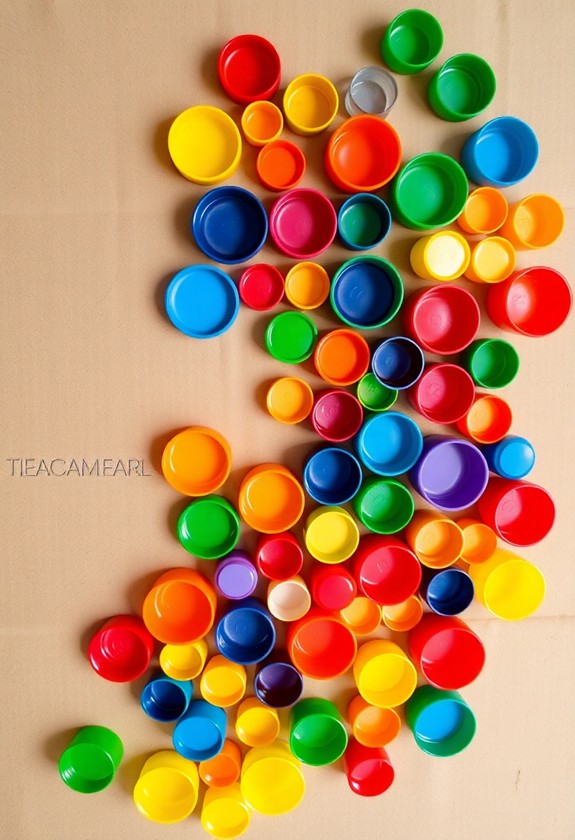
Bottle caps, once destined for the trash, can be transformed into lively works of art! You'll love this eco-friendly project that's perfect for little hands. Here's what you'll need:
- Colorful bottle caps
- Strong glue
- Cardboard or wood base
- Markers or paint (optional)
First, let your toddler sort the caps by color – it's a great learning opportunity! Then, help them arrange the caps on the base to create a fun design. Flowers, rainbows, or even silly faces work wonderfully. Once they're happy with the layout, it's time to get sticky! Assist your little artist in gluing each cap down firmly.
Want to add extra pizzazz? Use markers or paint to fill in gaps or add details. Voila! You've just created a cap-tivating masterpiece that's certain to bottle up some smiles!
Plastic Bag Finger Painting
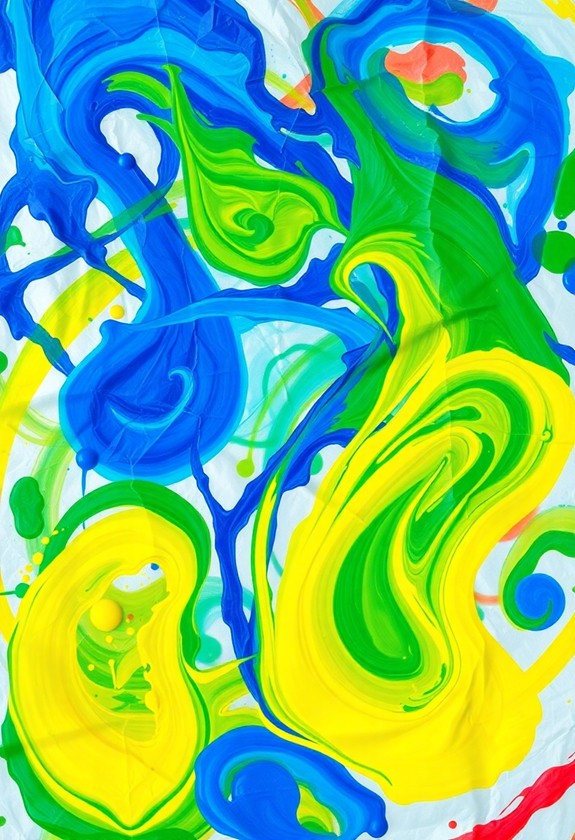
Now let's turn those plastic bags into an exciting, mess-free painting activity! You'll love this fun twist on finger painting that keeps little hands clean as creating colorful masterpieces.
Here's what you need:
- Clean plastic bags
- Washable paint
- Tape
How to do it:
- Squeeze dollops of paint onto a plastic bag.
- Tape the bag securely to a flat surface.
- Let your toddler go wild! They can squish, spread, and swirl the paint with their fingers.
The best part? No messy cleanup! When they're done, simply untape the bag and hang it up as instant art. Or, press a sheet of paper onto the painted bag for a unique print. It's like magic!
This "bag-tastic" activity is perfect for rainy days or when you need a quick, clean art fix.
Newspaper Collage Art
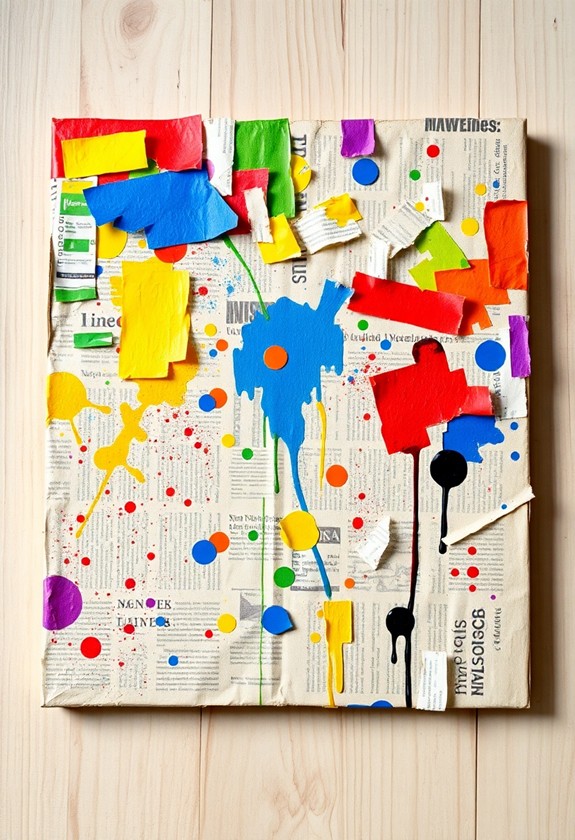
Let's investigate a classic eco-friendly art project that's perfect for toddlers: newspaper collage art. It's a fantastic way to reuse old newspapers and release your little one's creativity! Here's how to get started:
- Gather your supplies: newspapers, child-safe scissors, glue sticks, and a sturdy paper base.
- Help your toddler cut or tear newspaper into various shapes and sizes.
- Encourage them to arrange and glue the pieces onto the base paper.
Watch as your child creates a masterpiece! They'll love the tactile experience of handling different textures and patterns. Plus, it's a great opportunity to introduce concepts like shapes, colors, and spatial awareness. And the best part? You're giving new life to old newspapers as you nurture your toddler's artistic skills. It's a win-win situation that's both fun and eco-friendly!
Tin Can Pencil Holders
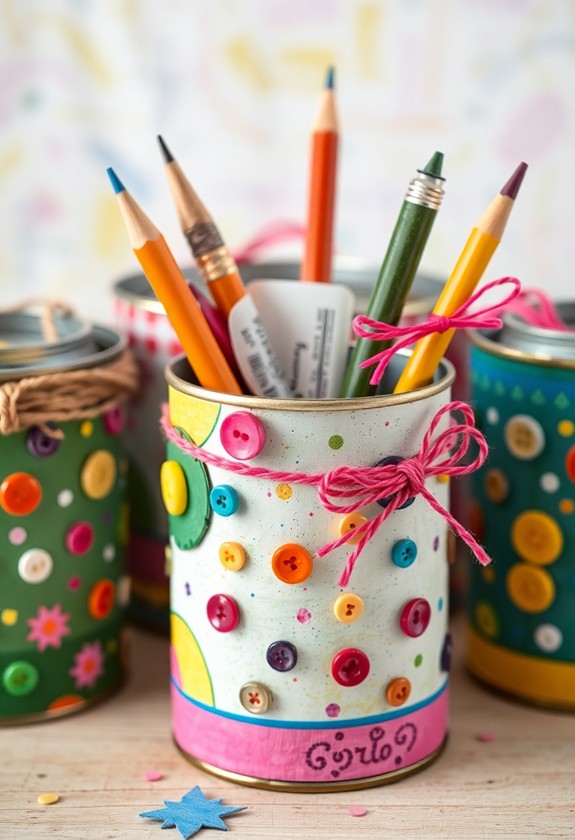
Frequently overlooked, tin cans make excellent materials for eco-friendly art projects with toddlers. Don't toss those cans! Instead, transform them into adorable pencil holders. It's a fun, easy, and budget-friendly activity that your little ones will love!
Here's how to create your tin can masterpiece:
- Clean the can thoroughly
- Remove any sharp edges (adults only!)
- Let your toddler paint the outside
- Decorate with stickers, glitter, or ribbons
Get creative! You can use different sizes of cans for variety. Why not try a "tin-tastic" family of pencil holders? Your kiddos will be "can-gratulating" themselves on their artistic skills!
Pro tip: Use non-toxic, washable paints for easy clean-up. And remember, supervise your little artists at all times. Let's get "can-crafting"!
Curious Little Questions
How Can I Safely Store Eco-Friendly Art Projects Long-Term?
Store it, preserve it, love it! You've got options for safekeeping your eco-friendly masterpieces:
- Use acid-free boxes or folders to protect from light and dust.
- Try air-tight containers with silica gel packets to control humidity.
- Create a digital gallery by snapping photos – it's space-saving and shareable!
- Frame special pieces with UV-protective glass for wall display.
- Make a scrapbook using recycled materials for a fun, compact solution.
What Age Group Is Best Suited for These Eco-Friendly Art Activities?
You're in luck! These eco-friendly art activities are perfect for toddlers and preschoolers, typically ages 2-5. But don't worry if your little one is younger or older – they can join the fun too! Younger babies might need more help, whereas older kids can get creative with advanced techniques. The key is to tailor the project to your child's skill level. Remember, it's all about exploration and creativity, not perfection. So grab those recycled materials and let the artistic adventure begin!
Are There Any Potential Allergens in These Eco-Friendly Art Materials?
You're right to ask about allergens! During most eco-friendly art materials are safe, there are a few things to watch out for. Some natural dyes might contain food allergens like berries or nuts. Clay could have wheat or gluten. And don't forget about potential plant allergies! It's always best to check labels carefully and test materials on a small patch of skin first. Remember, safety first, fun second! But don't worry, there are tons of allergy-free options out there for your little artist to investigate!
How Can I Incorporate Learning Objectives Into These Eco-Friendly Art Projects?
Get ready to kill two birds with one stone! You can easily weave learning into eco-friendly art projects. Here's how:
- Count and sort materials to boost math skills
- Teach colors during mixing paints
- Practice letter shapes with nature collages
- investigate textures to develop sensory awareness
- Discuss recycling during creating
It's a win-win situation! Your little ones will have a blast during learning important concepts. Plus, you're helping the planet. So, let's get creative and smart with these fun, educational art projects!
What Precautions Should I Take When Supervising Toddlers During These Activities?
Safety first, little artists! When supervising toddlers during art activities, you've got to be on your toes! Here are some must-do precautions:
- Keep a watchful eye at all times – no distractions!
- Use non-toxic, child-safe materials only
- Secure loose clothing and tie back long hair
- Have a first-aid kit nearby, just in case
- Guarantee proper ventilation for messy projects
- Set clear rules and explain them before starting

